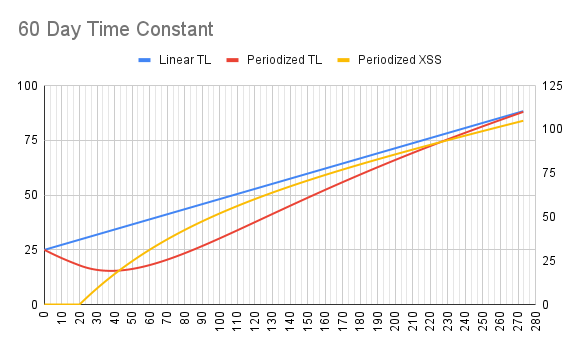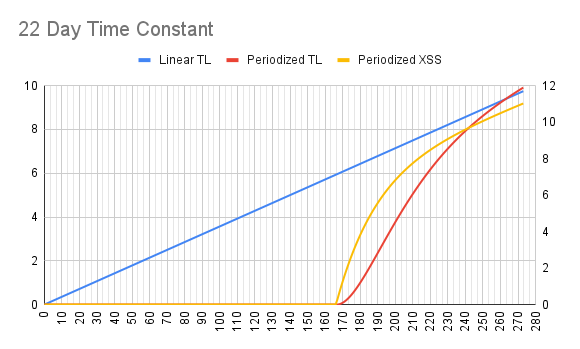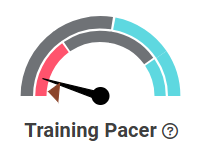Hi nice people, just dropping a message to let you know that I’m super interested in participating to the forecast AI beta. Currently training for the L’etape du Tour 2024 in Nice. Could be a long term trial.
Cheers!
Hi nice people, just dropping a message to let you know that I’m super interested in participating to the forecast AI beta. Currently training for the L’etape du Tour 2024 in Nice. Could be a long term trial.
Cheers!
Very excited for this. I love xert but having a long term adaptive plan would be game changing.
“Long term” has its limits. Just an FYI. According to our training model, anything more than about 100 days can easily be pure low intensity training, i.e. just base. More than about 250 days out or so, you probably don’t even need to train. As we’ve said before on our podcast, the further away your event, the less important hitting specific training targets are today.
Here’s an explanation of why. This chart shows the effect of periodizing your low intensity training (time constant of 60) over the course of 280 days, going from a low intensity training load of 25 to 90:

You can see that with this 280 day target, you wouldn’t need to start any training until about 260 days out.
For High Intensity (time constant of 22), going from 0 to 10 high intensity training load:

Training doesn’t really need to start until about 110 days before the event . It starts slow, “building” until it reaches the “peak” phase at around the 250 day mark (where it rises linearly).
Following the red paths, cuts your high intensity XSS by about 50% and low intensity about 15%. Far less training needed when you periodize.
The main drawback of periodizing your training is that you’ll need to sustain higher ramp rates. In this example, the total linear ramp rate is 2.1 points TL/week but for the periodized, it reaches a maximum of 3.6 points TL/week. Essentially the trade off is amount of training you would need to do (total XSS) vs. starting slower and doing a bit more challenging workouts relative to your fitness level. The other major concern over a 280 day structured training plan is burnout. You really don’t want to be following a plan that long.
Going from 25 to 90 in low training load is a big goal. Essentially this means going from barely trained to elite level when you add in high and peak training loads. In most cases, planning out 150 days is likely the most you want a plan for. Having said that, with our new capability, you don’t have to sit on a trainer or do only structured workouts so perhaps the burden and likelihood of burnout over longer training plans can be reduced. You’ll get outdoor or virtual rides recommended that will meet your training needs.
You’ll be hearing more about our new features, as release date approaches. Closed beta release won’t be long.
(…just jotting down some ideas for a blog post… comments welcome…)
Thank you, all makes sense. Any plans to be able to incorporate a B level priority event midway through the plan with a shorter taper?
Really interesting. The higher the TL you can maintain during “offseason” would mean when you start back “seriously”, you could have a less severe ramp right, right? It’s the idea that “you don’t really need to train” until 100 days out, that’s maybe throwing me a bit. For the high intensity side, are you saying there’s no point to do anything other than low intensity because you can build up HIE in approx 100 days? Surely, the higher HIE you start with, the higher you could get in the end?
Edit to add: If you accept a target of 90 TL, rather than ‘as high as you can get it’, I think I get it better.
Yes. We have that capability already just need a way to create and manage events. There are some other super-cool things we’re looking to add to the event creation and management process. (Sigh… wish all this was ready now too!). Hard to commit to a date since it’s another ambitious project but we’re making good progress here.
The higher you start with, the higher you end with for sure but the trade off is in the amount of XSS you need to do. With high and peak having such a short time constant, doing a high intensity workout 120 days out while it makes you end with a larger training load, it’s not really worth it. The nominal increase it provides is something you could easily tack on to your training as the event gets closer.
To give you an example, say you have a workout that has 20 high XSS. 120 days out, the increase in high training load it generates on event day is 0.004. 20 days out, the increase is 0.4. If the goal is to get to 10, you can see how the workout with 20 high XSS (not an easy workout) isn’t really going to provide much benefit when you do it 120 days out. You might as well avoid the fatigue and just do an endurance workout 120 days out and plan for a high intensity workout with 20.2 XSS 20 days out and reach the same point.
There are situations where reverse periodization can make sense though. These usually involve trying to get to much larger training loads where you need the larger load values earlier in order to build it.
I think I follow now.
Any time you’re adding TL, some is dissipating, at the same time. You’re simply saying that the closer you get to a target date, it’s dissipating less quickly, so the effect of the added high TSS would be more pronounced?
Maybe to your earlier post, I wish we had a way to model the season by ramp rate and required XSS per day/week, and to contrast a linear ramp with ramps where RR changed by period.
Hold that thought.
Was there just a change rolled out that pre-base is now an Endurance Focus (as opposed to Breakaway Specialist), or am I imagining things?
I just noticed the exact same thing. ![]() This makes more sense.
This makes more sense.
Set a TED to 121 days out and you’ll see Pre-base suggests selected Athlete Type focus when form is Fresh.
It’s only at 120 days when you may notice a discrepancy between Pre-base on the slider and Base in XATA, but that makes sense since midnight is the trigger point.
Not sure how they intend to handle Pre-base activity for forecasting purposes, but IME if you don’t schedule some downtime before starting a progression (or deliberately scale back when starting Base) you’re limiting uptime gains during Build and Peak phases.
I don’t think enough riders give credence to doing this at some point(s) during the year. ![]()

That’s probably it. I might have just crept into the 120 day window. I’m a bit confused because lots of sources say to include intensity in the off season, but Armando was showing how the model indicates maintaining high TL in the off season might not be worth it. After all these years of training, I’m more and more convinced that the real reason to periodize is the mental break.
I don’t think Xert should have it as a limit, but I think considering your max difficulty throughout the year isn’t a bad idea. For example, in the heart of your offseason, regardless of your fitness stars, maybe limit yourself to 2 or 2.5 star workouts, just to save your sanity.
Ride for fun. Find new coffee shops. Try gravel/other riding. Cross-train. Spend more time with family. These act as a nice mental break and set you up to have a better and stronger following year. Your fitness may see a reduction but you’ll have plenty of time to ramp it back up and can still hit new levels with the right plan and attitude.
I personally like to ride for fun. I still like to get the odd breakthrough and see if I still “have it” even though I’m not actively managing my fitness.
Well said.
How can I get on the Beta testing? Would work quite well as I’m a heavy user Xert in that I spend more time playing around with it than training ![]()
Also happy to join!
Tried to create a forecast AI plan for an event (short crit road race in june 2024). After calculating for a while I got the error message: “An optimal plan for your event could not be found.”, and I can not save the plan.
Any ideas?
I think @xertedbrain mentioned this previously. It is not an error (bug), just a message saying you should change some of your parameters. I am not part of the beta so I cannot tell what you can change, but most likely you have higher ambitions that the available time allows for ![]()
So have a look at your goals/targets and see if you can adjust them down a bit. Or allow for more time to the goal. If you share a screenshot of the parameters here I am sure it is easier to help.
Messages are being updated…